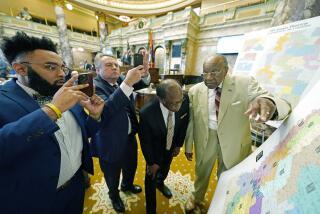Supreme Court rejects Texas election map that favored Latinos
Reporting from Washington — The Supreme Court gave an early win to Texas Republicans in the fight over redrawing election districts and the balance of power in Congress, ruling that the district lines should mostly follow those set by GOP lawmakers and not those by judges who drew new boundaries to favor Latinos.
The 9-0 decision set aside a new map of congressional districts drawn by a special federal court in San Antonio that gave Latinos and Democrats a good chance to win three or possibly four new seats in the House of Representatives.
Friday’s opinion was the high court’s first word on the once-a-decade clash between states’ rights and voting rights in the highly political business of drawing election districts. And states’ rights was the clear winner, possibly a portent of other voting-rights disputes, such as a challenge to South Carolina’s new photo identification requirement.
The main theme in the court’s opinion was that states and their lawmakers, not judges or civil rights lawyers, should decide the political questions involving voting and elections. At one point, in an ominous note for voting-rights activists, the court said that the Voting Rights Act itself raises “serious constitutional questions” because of its “intrusions on state sovereignty.”
“Redistricting is primarily the duty and responsibility of the state,” the justices said. They faulted the district court in San Antonio for having “substituted its own concept of the ‘collective public good’ for the Texas Legislature’s determination of which policies serve the interests of the citizens of Texas.”
The new map should “reflect the state’s policy judgments on where to place new districts and how to shift existing ones in response to massive population growth,” the high court said.
Under the plan drawn last summer by the Texas Legislature, Republicans were seen as likely to win as many as 26 of the state’s 36 seats in the next Congress, including three or four of the new districts.
The backdrop to the Texas dispute involves the nation’s growing Latino population and whether states will be forced to give more clout to Latino representatives. This year also marks the first time a Democratic administration in Washington has overseen the Voting Rights Act when new census data requires states to redraw election districts. And under one part of this law, the Southern states must “pre-clear” all changes in their election systems with Washington.
The stage was set then for a clash between the Democratic administration and the mostly Republican-led states on how to draw the new districts. Obama administration lawyers joined Latino leaders in objecting to the Texas plan. They said it denied Latinos fair representation, because most of the population gain was due to the growth in the Latino population.
While Friday’s ruling gives Texas officials much of what they sought, it is not a final victory for them. In addition to the court in Texas, another special federal court in Washington is also weighing legal challenges to the Texas plan.
“This is a train wreck of a case. This was a significant victory for Texas today, but the case will probably come back to the Supreme Court again,” said Richard Pildes, an election law expert at New York University.
Latino activists said they were cheered that the high court did not give Texas a green light to put into effect now its GOP-friendly state plan. The justices repeated their long-standing view that a “new election map cannot be used” in a state such as Texas until it has been pre-cleared.
Because that issue is still pending before the three-judge court in Washington, the justices told the court in San Antonio to try again to draw an “interim” map for Texas that could be used in the 2012 elections while the court in Washington addresses the pre-clearance issue.
Nina Perales, an attorney for the MALDEF in San Antonio, said she remained optimistic the new Texas map would include more districts likely to elect Latinos. She said the trial in San Antonio has shown the state’s plan discriminates against minority voters. “We created a strong record and look forward to the redraw process under the guidance given by the Supreme Court,” she said.
Texas Atty. Gen. Greg Abbott disagreed and predicted the state’s plan would prevail. “The court made clear in a strongly worded opinion that the district court must give deference to elected leaders of this state,” Abbott said in a statement.
The Supreme Court justices remain sharply split over the Voting Rights Act and whether courts should force states to draw districts along racial lines. Chief Justice John G. Roberts Jr. has referred to that as a “sordid business.” Two years ago, the court came close to striking down the pre-clearance part of the Voting Rights Act as unconstitutional. But liberal justices have said the court has a duty to protect the electoral clout of minorities.
Friday’s 11-page opinion was unsigned, and there were no dissents. Justice Clarence Thomas filed a concurring opinion repeating his view that Voting Rights Act was unconstitutional. The Texas plan should be allowed to take effect immediately, he said.
More to Read
Sign up for Essential California
The most important California stories and recommendations in your inbox every morning.
You may occasionally receive promotional content from the Los Angeles Times.











